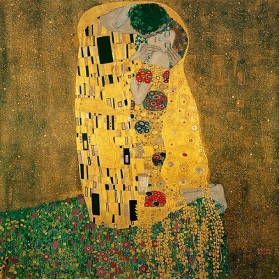The Artist’s Background
Gustav Klimt was an Austrian painter born in 1862 in Vienna who, in a certain way, revolutionized the way love and sexuality can be represented in art. Klimt was among the most progressive artists of the time: in 1897, he and other like-minded creators established the “Vienna Secession” movement, which was Austria’s prevailing conservatism and aimed to draw attention to contemporary creative thought (Fearon, 2019). A decade after its formation, Klimt would create his masterpiece, “The Kiss,” a painting that would go on to become one of the most recognizable art pieces in the history of art.
The History of the Painting

Gustav Klimt had a unique style that makes the viewer instantly recognize the authorship of a work. Klimt’s most celebrated period was his “Golden Phase,” characterized by his extensive use of gold leaf (Fearon, 2019). This era peaked in 1907, characterized by “The Kiss” and other pieces that would go on to be among his most renowned works.
In this style, he drew inspiration from Byzantine mosaics and the architecture he witnessed in Ravenna, which he visited prior to embarking on creating “The Kiss.” Inspired by the dazzling effects of the mosaic decorations in the San Vitale church, he sought to combine this iconography with his portrayal of feminine pleasure (Fearon, 2019). Klimt was also inspired by the Arts and Crafts Movement in Britain and Art Nouveau (Fearon, 2019). These components created a unique style in his painting.
In his work, Klimt aspired to focus solely on a man and a woman as a single whole. He decided to leave only the romantic, erotic, and sensual, getting rid of all the social expectations regarding love (Hodge, 2019). In the painting, a kiss is communicated as something natural, the feeling of shame and guilt. The pair is intricately entwined, illustrating the profound depth of intimacy between two individuals in love with each other. The lovers are cloaked in intricate, golden patterns, which evoke both sensuality and spirituality.
After the painting was unveiled to the public, it was met with mixed reactions. While some were astounded by the revolutionary style and portrayal of intimacy, most viewers felt scandalized by the painting due to the obvious erotic undertones (Hodge, 2019). The art establishment of Vienna had a polarized response as well.
Despite the ambiguous reaction, in 1908, the artwork was acquired by the Belvedere Museum and became the most expensive painting sold in Vienna at the time (Fearon, 2019). Over the next century, the piece only kept on gaining recognition among art critics and regular viewers alike. At the current moment, Klimt’s work is considered to be a timeless symbol of deep love and passion and is recognized and loved by millions.
A Poem Inspired by the Painting
The kiss of two. A symphony of love and gold,
Two lovers’ forms. Their passion, deep and pure.
With spirits intertwined, in every stroke of brush.
Amidst a field of blossoms, they repose,
Slow dancing, melting in each other’s breath.
A timeless kiss, an intimate embrace.
Each stroke, a whisper of desire’s plea.
A tapestry of glee, a golden robe.
Their bodies merge, a luminous ballet.
With patterns bold and colors that inflame,
The canvas shimmers in the softest light.
Love’s deep connection. Dreamlike sentiment.
Blessed are my eyes by such a love.
A flutter fills this captive heart of mine.
In every detail, every hue and stroke,
I see a love that is forever pure.
A deep and heartfelt sigh left in my soul.
A moment frozen still, a lovers’ kiss.
A world aglow, enduring passion’s will,
Where love and art as one, forever flow.
References
Fearon, F. (2019). The real stories you need to know about Gustav Klimt’s ‘The Kiss’. GQ. Web.
Hodge, A. N. (2019). Gustav Klimt. Arcturus Publishing.
Klimt, G. (1907-1908). The kiss [Oil on canvas]. Belvedere Museum, Vienna. Web.